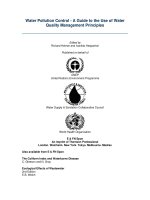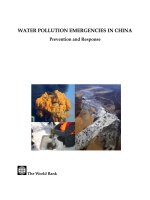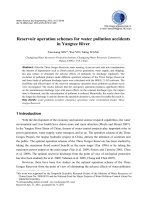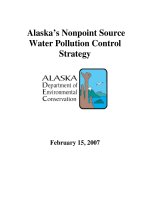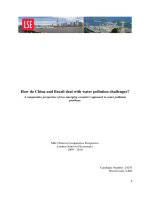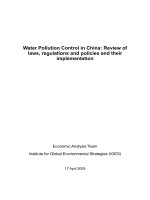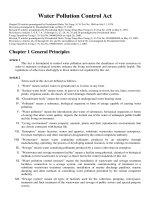Water Pollution Control in China: Review of laws, regulations and policies and their implementation pptx
Bạn đang xem bản rút gọn của tài liệu. Xem và tải ngay bản đầy đủ của tài liệu tại đây (580.75 KB, 45 trang )
Water Pollution Control in China: Review of
laws, regulations and policies and their
implementation
Economic Analysis Team
Institute for Global Environmental Strategies (IGES)
17 April 2009
ii
Water Pollution Control in China: Review of
laws, regulations and policies and their
implementation
Edited by
Xin Zhou
Economic Analysis Team, Institute for Global Environmental Strategies (IGES)
for
Study on Enforcement of Water Pollution Control in
China, ERIA-SD Project
iii
Yao Qi
Graduate School of Frontier Sciences, Department of Environmental Studies
The University of Tokyo
2-1, 37-108, Toyoshikidai, Kashiwa, Japan 277-0845
Xin Zhou
Economic Analysis Team, Institute for Global Environmental Strategies (IGES)
2108-11 Kamiyamaguchi, Hayama, Kanagawa, 240-0115 Japan
Telephone: +81-46-855-3863
Fax: +81-46-855-3809
E-mail:
URL:
iv
Abstract
The Economic Research Institute for ASEAN and East Asia (ERIA) was established
in June 2008, aiming to pursue three pillars of research issues, “Deepening
integration”, “Narrowing Development Gaps”, and “Sustainable Development”.
Under the pillar of “Sustainable Development”, a project on mainstreaming
sustainable development policies in East Asia (ERIA-SD project) was initiated for the
period 2008-2010 and IGES is responsible for its coordination. The purpose of this
project is to promote sustainable development concerns into policy making process in
this region, in particular developing countries. Under the ERIA-SD project, IGES
conducted a study on the enforcement of water pollution control in China, for which
we prepared this policy review.
The purpose of this report is to review China’s environmental laws, regulations and
policies with special focus on water pollution prevention and control. In this report,
we analyse the evolution process of environmental laws and regulations in China with
special emphasis on water pollution control. The environmental legal system and
environmental management organizations are illustrated. We also introduced major
implementation measures for the enforcement of environmental laws and regulations
and provided two case studies to indicate the current situation and future trend of
China’s water pollution control.
v
Table of contents
Abstract iv
1. Introduction 1
2. Evolution of environmental laws and regulations in China with special
emphasis on the protection of water environment 2
2.1 Three evolution stages of China’s environmental protection 2
2.2 Water resource management 6
2.3 Summary 7
3. System of environmental laws and regulations and their
implementation in China 8
3.1 Hierarchy of environmental laws and regulations 8
3.2 Hierarchy of environmental management organizations at various levels and their major
responsibilities 11
3.3 Summary 16
4. Enforcement of environmental laws and regulations in China with
special focus on the protection of water environment 17
4.1 Major legal and administrative measures for implementation 17
4.2 Enforcement of pollution prevention and control laws and regulations 24
4.3 Other policy measures 27
4.4 Summary 29
5. Case studies 32
5.1 Water pollution in Taihu River Basin 32
5.2 Energy saving and emission reduction 36
6. Conclusions 37
References: 38
1
1. Introduction
The Economic Research Institute for ASEAN and East Asia (ERIA) was established in June
2008, based on the official endorsement at the third East Asia Summit by sixteen member
countries. ERIA Research Project aims to pursue three pillars of research issues, “Deepening
integration”, “Narrowing Development Gaps”, and “Sustainable Development”. Under the
pillar of “Sustainable Development”, a project on mainstreaming sustainable development
policies in East Asia (ERIA-SD project) was initiated for the period from FY2008-2010 and
IGES is responsible for its coordination. The purpose of this project is to promote sustainable
development concerns into policy making process in this region, especially developing
countries. Under the ERIA-SD project, a study on the enforcement of water pollution control
in China is identified as one of its thematic studies.
The purpose of this report is to provide a preliminary review on China’s environmental laws,
regulations and policies with special focus on water pollution prevention and control. Base on
this policy review, we will assess major factors influencing the effectiveness of China’s
enforcement of water pollution control and further analyze the contribution of environmental
investment and technology to environmental enforcement in China.
China’s environmental statistical data, legal document and relevant internet information are
used as main data resources for this report.
Rest of this report is organized as follows: Part 2 introduces the evolution process of
environmental laws and regulations in China with special emphasis on water pollution control.
Part 3 illustrates environmental legal system and environmental management organizations.
Part 4 explains major implementation measures for the enforcement of environmental laws
and regulations. Part 5 provides two case studies to indicate the current situation and future
trend of China’s water pollution control. Part 6 concludes this report.
2
2. Evolution of environmental laws and regulations in China
with special emphasis on the protection of water environment
With intensive growth of heavy industries, water pollution accidents happened, which alongside
with the Stockholm Conference on Human and Environment (1972) aroused the attention of
Chinese government in the early 1970s. This stimulated the establishment of Leading Group on
Environmental Protection of the State Council (LGEP), China’s initial environmental
administrative organization. By the end of 1980s, a comprehensive environmental management
system had been set up consisting national, local and sectoral governmental environmental
organizations. However, the level of environmental degradation due to rapid economic growth
surpassed the progress made in environmental protection and environmental quality has been
deteriorating. Many environmental accidents and ecological disasters happened in 1990s, such as
arseniasis pollution in drinking water, acid rain, sandstorms and floods. After the Rio Earth
Summit on Environment and Development in 1992, China introduced the concept of sustainable
development into its environmental law-making and policy-making and has gradually developed
its own theory based on the Scientific Outlook on Development.
Similar to other countries, the evolution of China’s environmental management system also
experienced from point source pollution control to non-point source pollution control; from
individual source pollution control to comprehensive river basin management; from singular
mandatory administrative measure to policy mix of multiple tools and means; from end-of-pipe
abatement and cleaning-up to pollution prevention; and from emphasizing the quantity of
economic growth to the quality of growth based on sustainable development.
2.1 Three evolution stages of China’s environmental protection
The evolution of environmental protection in China can be divided into three stages according to
the changes of guiding ideologies as well as developing level of legislation and institution system.
The features of each stage are shown in Table 1.
Table 1 Features of each stage of the evolution of environmental management system
1), 2), 3), 4), 5)
Stage 1 (1972~1983) Stage 2 (1983~1991) Stage 3 (1992~present)
Legislation
♦ Constitution(1982)
♦ Environmental Protection Law
(Trial Version)(1979)
Total
1
: 2 laws
♦ Environmental Protection Law(1989)
♦ Water Pollution Prevention and Control
Law(1984)
♦ Air Pollution Prevention and Control
Law(1987)
Total
1
: 7 laws and 8 regulations
♦ Solid Waste Pollution Prevention and Control
Law(1995,2004)
♦ Radiation Pollution Prevention and Control Law(2003)
♦ Environmental Impact Assessment Law(2002)
♦ Cleaner Production Law(2002)
Total
1
: 27 laws and 25 regulations
Institution
Development
♦ Leading Group on Environmental
Protection, State Council(1972)
♦ Department of Environmental
Protection, Ministry of Urban
and Town Construction(1982)
♦ National Environmental Protection Agency
(1988)
♦ State Environmental Protection Administration (1998)
♦ Ministry of Environmental Protection (2008)
Major Implementation
Measures
♦ Three Simultaneity System
♦ Pollution levy system
♦ Environmental impact
assessment system
♦ Target-responsibility system for
environmental protection
♦ Quantitative examination of integrated
environmental management
♦ Emission permit system
♦ System of centralized control
♦ Enforcement of pollution abatement to
noncompliance by designated date
♦ Total emission control
♦ Cross-century green projects
♦ Levy on centralized waste water treatment in urban area
Major
Events
Domestic
♦ The First CNCEP
2
(1972), the
starting point of environmental
protection work in China
♦ The second CNCEP
2
(1983), setting
environmental protection as a fundamental
national policy
♦ “Zero point” action(1997, 1998)
♦ Environmental enforcement campaign(2003~present)
♦ The Third Session of the Sixteenth CPPCC
3
National
Committee (2003), Scientific Outlook on Development
International
♦ Stockholm Conference on
Human and Environment(1972),
arousing environmental
awareness worldwide
♦ Rio Earth Summit(1992), promoting sustainable
development
♦ Kyoto Protocol, solving global warming problem
Major Pollution
Accidents
♦ Water Pollution in Dalian Bay
(1972, big loss in aquaculture)
♦ Water Pollution in Guanting
Reservoir(1972, caused sickness
of local residents)
♦ Flooding of Yangtze River in 1998 (economic loss: 255
billion RMB; 1320 death)
♦ Tai lake water pollution (1990, 1995, 1998, 2007,
drinking water crisis)
♦ Songhua river water pollution accident (economic loss: 69
million RMB; 8 death)
Notes: 1. present total number including revised versions; 2.CNCEP=China National Conference on Environmental Protection; 3.CPPCC=Chinese People's Political Consultative Conference;
4.“three simultaneity”= pollution abatement facilities must be designed, constructed and operated the same time with the main project.
3
4
(1) Stage 1: 1972~1983
Invoked by several environmental pollution accidents happened in 1972
5)
, this stage is a
foundation of China’s environmental protection work. There are several millstones for the starting
of organization construction, legislation and management framework. The Stockholm Conference
marked the beginning of environmental awareness of Chinese central government; the first
China
National Conference on Environmental Protection(CNCEP) marked the beginning of
environmental awareness of governments of all levels; the foundation of LGEP marked the
beginning of construction of environmental administrative organizations; the Environmental
Protection Law (Trial Version) marked the beginning of environmental legal system; the guiding
principles specified by 32 Chinese characters, i.e. overall planning, rational layout, comprehensive
utilization, recycling, public participation, taking initiative action, environmental protection and
benefiting the whole society, which marked the beginning of environmental policy making.
In this stage, China’s economy highly relied on heavy industries, such as iron and steel industry,
chemical industry and machinery manufacturing industry. All of these heavy industries produced
great amount of pollutants, especially “three wastes”, i.e. waste water, waste gas and solid waste
6)
.
As a result, most of management measures of this stage were imperative administrative orders
aimed to enforce end-of-pipe abatement. Three major implementation measures in this stage (so
called “old three measures”) were: Three Simultaneity System, environmental impact assessment
system and pollution levy system. The first two focused on the pollution prevention and the last
one added in economic stimulation. These three measures were well executed at that time and still
play an important role at present.
(2) Stage 2: 1983~1991
China's environmental protection achieved significant development in this stage. Environmental
protection was confirmed as a fundamental national policy during the second CNCEP, and
strengthening environmental management was confirmed as a policy priority for environmental
protection. Therefore, the amended Environmental Protection Law (1989) and six environmental
individual laws were enacted successively. NEPA was found in 1988, and local Environmental
Protection Bureaus (EPBs) were also set up nationwide. By then, basic framework of legal system
and environmental institutions has been set up
3)
. Environmental protection was added into national
developing plan since the Seventh Five-Year Plan, which embodied the concept of coordination
between environmental protection and economic growth.
In this stage, China’s economy increased rapidly by an average annual growth rate of 10%.
However, high energy consumption and high material consumption result in high emissions.
During this period, the implementation rate of the “old three measures” increased year by year. For
example, the implementation rate
1
of EIA for large and medium sized projects was almost 100%
while the implementation rate
2
of “Three Simultaneity System” was about 96%
4)
. Based on the
new features of economic-social development of that time, “new five measures” were proposed,
1
Ratio of projects that executed EIA among all projects that should execute EIA.
2
Ratio of project that executed “Three Simultaneity” among all construction projects.
5
viz. target-responsibility system for environmental protection, quantitative examination of
integrated environmental management, emission permit system, system of centralized control, and
enforcement of pollution abatement for noncompliance by designated date. By then, the
management structure consisting of eight major implementation and enforcement measures was
established. Target-responsibility system is set between central and local government. Quantitative
examination of integrated environmental management is of planning level. System of centralized
control is of tactical level. And the other three measures are of specific level. Different from stage
one, various economic instruments were introduced into the management system besides
imperative administrative orders, such as subsidy on pollution abatement, tax preferential policies
on comprehensive utilization of wastes, resource tax and compensation fee. These measures
stimulated the enthusiasm of enterprises on environmental protection.
(3) Stage 3: 1992~present
The Rio Earth Summit (1992) was a milestone for the beginning of considering sustainable
development in policy making of China’s environmental protection
5)
. In this stage, both legislation
and institution construction were improved to a new level. By now, 26 environmental individual
laws and more than 50 environmental protection administrative regulations in total were enacted
1)
.
After upgraded to SEPA (1998), China’s environmental administrative authority was upgraded
again to MOEP in 2008.
In this stage, China’s economy has grown rapidly under the
socialist market-based economic
system. However, industrial sectors contributed not only to economic development but also to
pollution, which results in serious air and water pollution especially in urban areas. Environmental
pollution accidents and ecological disasters greatly stimulated China’s environmental protection.
For instance, water pollution accidents of Taihu Lake(1990, 1995, 1998, 2007) and Huai
River(1989,1994, 2004) caused water shortage to nearby factories and drinking water crisis to
millions of people, with direct economic loss over 100 million RMB
7)
. Those accidents stimulated
the establishment of regulations for water pollution prevention of major river basins and the
regulations for protecting safe drinking water. The revised Water Pollution Prevention and Control
Law enacted in 2008 also added related content for protection of drinking water source. The “Zero
point” action was implemented to strengthen environmental enforcement in both 1997 and 1998.
In these enforcement campaigns, pollutants from enterprises of Taihu or Huai river basin must
attained national emission standard by 0:00am on December 31st in that year. From 2003, SEPA
and EPBs conducted environmental enforcement campaign annually by intensive inspections to
polluting enterprises. Those activities achieved immediate but temporary outcome by shutting
down tens of thousands serious pollution township and village enterprises (TVEs).
The flooding of Yangtze River in 1998 was a serious catastrophe in China’s modern history, which
caused 1320 death and direct economic loss at 225 billion RMB. This accident attracted great
attention by Chinese top leaders on the situation of severe environmental and ecological
deterioration situation. And it also stimulated the enactment of forest law and meteorology law and
other resource conservation laws.
6
The Songhua River pollution accident in 2005 caused 6 deaths, 69 million RMB of direct
economic loss and serious pollution of drinking water source. After this accident, environmental
supervision all over China was particularly strengthened through establishing Provincial
Environmental Supervision Bureaus and increasing investment on equipments. Meanwhile, this
accident stimulated the establishment of contingency plan for environmental emergencies and it
was also a main reason to put drinking water safety in priority in the eleventh Five-Year Plan
8)
.
In this stage, four major implementation measures were proposed: total emission control,
cross-century green projects, levy on centralized waste water treatment in urban area, and
emission reduction. Especially, the transformation from concentration control to total emission
control greatly enhanced the treatment rate
1
of pollution sources. Meanwhile, many economic and
integrated instruments were used. For example, CO
2
emission trading helps to distribute resource
rationally. Green GDP accounting, environmental labeling, and ISO14000 EMS work as incentive
to enterprises environmental pretention. Disclosure of environmental information complements
the limited capacity of administrative supervision.
2.2 Water resource management
Compare to air pollution and solid wastes, water pollution has more direct impact on human health,
since the symptom may appear immediately. Because human beings need to drink water every day,
the insufficiency of safe drinking water can even cause social unrest. For the above reasons, water
protection has always been a priority in the development of environmental management system in
China.
In 1972, water pollution in Dalian Bay (city) caused more than tens of thousands of loss of marine
output every year; another water pollution of Guanting reservoir caused fish pollution; and the
water pollution accident in Songhua River caused Minamata disease of local people who ate fishes
from polluted river. It was these water pollution accidents that arouse the environmental awareness
of Chinese leaders and started environmental protection in China
5)
. Then, in stage 3, once again,
those water pollution accidents acted as activators of environmental protection. For example,
water pollution accidents in Huai River and Tai Lake in 1990s made the Chinese government shift
its emphasis to drinking water safety and river basin management; while flood in 1998 stimulated
the ecological protection.
In the process of legislation development, it is noticed that laws and regulations concerning water
environment management are usually developed earlier than those of air pollution control or solid
waste management. For example, the Water Pollution Prevention and Control Law enacted in
1984 was three years earlier than the Air Pollution Prevention and Control Law and eleven years
earlier than the Solid Waste Pollution Prevention and Control Law. And it was even earlier than
the Environmental Protection Law which was officially enacted in 1989
1), 2)
.
New guidelines and new implementation measures are also implemented first in water laws and
1
The part of treated pollutants out of all emission.
7
regulations. For instance, pollution levy system, environmental impact assessment reporting
system, spot inspection system, system of pollution discharge reporting and enforcement of
pollution abatement for noncompliance by designed date system were all first confirmed as legal
provision in the Water Pollution Prevention and Control Law in 1984. And the emission permit
system was first confirmed as legal provision in the implementation details of water pollution
prevention and control law in 1989
3)
.
Meanwhile, in the “implementing Scientific Outlook on Development documents”, water
pollution control was point out as the most important work for Chinese government in the near
future
9)
. In summary, water pollution accidents impel the development of environmental protection
work while water environment is the experimental field for new management measures.
2.3 Summary
In summary, politics, economy, technology, international cooperation and public awareness are
major factors that stimulate the development of China’s environmental management policy. Firstly,
ecological civilization and material civilization are the two preconditions for political civilization
of a society, since serious environmental pollution accidents may cause social unrest. On the other
hand, politicians’ attention on environment directly affects the quality of environmental protection.
And China’s environmental protection strongly affected by political will of top leaders. Secondly,
it is believed that environment has strong correlation with economic development. Economic
development need resource and damage environment most of the time, but economic development
can also provide money for pollution abatement. Economic loss of environmental accidents
stimulated the development of environmental policy making in China, and rapid economic growth
also provided billions of investment on environmental projects. Thirdly, technology development
may contribute to energy saving, lower cost of pollution abatement and accuracy of environmental
monitoring. Fourthly, environmental issues are global, so international cooperation is needed to
solve environmental problems. China’s environmental protection was first inspired by the
Stockholm Conference, and then other international conferences such as Rio Summit also have
great influence on guideline of environmental protection in China. As a developing country, China
can learn from past experience of developed countries, but at the same time, China also faces
heavy international pressure on its environmental issues. Finally, public awareness on environment
is the most important factor for the success of environmental protection in China. The
implementation of all policies needs support from public and the public can also influences
decision making of governments in certain ways. In China, public participation rate in
environment is still weak, so how to promote public participation may probably become the future
trend in China’s environmental policy.
8
3. System of environmental laws and regulations and their
implementation in China
This part will introduce environmental legislation system, legislation body, environmental
management organizations, and their development.
3.1 Hierarchy of environmental laws and regulations
China’s environmental legal system is shown in Fig.1. At present, there are one environmental
protection law; 26 environmental individual laws, including 15 nature resource laws; more than 50
environmental protection administrative regulations; and over 1600 local environmental decrees
and rules
1)
.
In China’s legal system, the Constitution, the criminal law and the civil law are fundamental
national laws which have the highest status over all laws and perform as basic guidelines for other
laws. Contents on environmental protection were first introduced into the Constitution in 1982. It
was explicitly stipulated in article 9, 10, 22 and 26 that “The country protects proper use of natural
resources, precious animals and plants. The country protects living environment and ecology,
prevent and control environmental pollutions”. Over the past thirty years, the Constitution has
been revised four times, however, environmental protection remains as an essential part. The
Criminal Law Code was first enacted in 1979 and revised in 1997. It is explicitly stipulated in
Chapter 6 that “Damaging environment is a specific crime and have to commit criminal
responsibility”. The General Principles of Civil Law was enacted in 1986 and it is explicitly
stipulated in Chapter 6 that “Anyone who damages the environment should commit civil
responsibility”
2)
.
Environmental Protection Law (trial version) was enacted in 1979. After ten years’ supplement
and amendment, this law was officially issued in 1989. The main content of Environmental
Protection Law consists of objectives, scope, guideline, basic principles, policies, key measures,
management systems, organizing structures and legal responsibilities, etc. This law is a
comprehensive substantive law which is adapt to the complexity of the environmental issues. This
law also enjoys very high status in the whole legal system, preceded only by the Constitution and
other foundational national laws. Therefore, this law acts as the basis for environmental protection
work and legislation
2)
.
criminal law civil law
Fundamental
National Law
Environmental Protection Law
Water Pollution Prevention
and Control Law
Basic Environmental
Laws
Individual
EnvironmentalLaws
Laws
Radioactivity Pollution
Prevention and Control Law
Water Law
Water and Land
Conservation Law
Circular Economy
Promotion Law
Noice Pollution Prevention
and Control Law
Environmental Impact
Assessment Law
Pollution Prevention and Control Laws
Resource Conservation and
Utilization Laws
Administrative
Regulations
Administrative
Rules
Local Decrees
and Rules
Regulations and Rules
Such as “implementation details of water pollution prevention and control law”, “provisional regulation on water
pollution prevention and control of Huai river”, “contingency plan for environmental emergencies”, etc.
Such as “preliminary hearing management method of construction land using”, “management measures of marine
natural reserve area”, “pollution prevention measures for hazard chemical waste”, etc.
Such as “pollution prevention methods for Wangyao water reservoir of Yanan city”, “water pollution prevention
and control ordinance of Wuxi city”, “water pollution control measures of Yangzi river in Jiangsu province”, etc.
Environmental
management Laws
constitution
Air Pollution Prevention
and Control Law
Solid Waste Pollution
Prevention and Control Law
Others
Others
Fig.1 Environmental legal system in China
3)
9
10
Individual environmental laws are made according to the guidelines in the Constitution and
Environmental Protection Law, which aim to protect certain kind of environmental element or
restrict certain kind of activity. Different from the Constitution and Environmental Protection Law,
individual laws make concrete and meticulous regulations on management. Base on different
functions, the individual laws can be divided into three groups. The first group is pollution
prevention and control laws. At present, there are five such laws, Water Pollution Prevention and
Control Law, Air Pollution Prevention and Control Law, Solid Waste Pollution Prevention, Noise
Pollution Prevention and Control Law and Radioactivity Pollution Prevention and Control Law.
These laws focus on the pollution control of a certain kind of pollution source, but there are also
contents related to resource protection and management. The second group is resource
conservation and utilization laws. At present, there are sixteen such laws, Grassland Law, Forestry
Law, Water Law, etc. These laws focus on natural resource reservation and management. The third
group is environmental management laws. At present, there are five such laws, Environmental
Impact Assessment Law, Circular Economy Promotion Law, etc
1)
. These laws are made to support
environmental management and to promote sustainable development.
In the view of legislative body, the Constitution is constituted by the National People’s Congress
(NPC); the Environmental Protection Law is constituted by the Standing Committee of NPC; and
the individual laws are constituted by the Environment and Resource Committee of NPC. The
NPC is the only institution that can constitute laws
3)
.
In order to ensure the implementation and clarify the operation process of special environmental
protection laws, as well as compensate for the inadequacy of present laws, the State Council,
MOEP and other relevant national administrative authorities establish various regulations and
rules, which include measures for the implementation of each environmental pollution prevention
and control law; technical specifications of pollutant disposal; emission standard of major
pollutants in various industries; management ordinance of certain pollutant or certain area;
operation plan of new systems; solutions of certain problems; list of dangerous pollutants;
important decisions towards certain major event, etc.
1)
Although the State Council and
administrative authorities can not make laws, they have the right to submit proposals to the NPC
when necessary.
Since the level of economic development and technology level is different among regions, and so
is the natural resource allocation, it is necessary to establish local environmental protection laws,
regulations and rules. They also embody the important spirit of “adaptation to local conditions”.
Basically, Local People’s Congresses (LPC) are responsible for making local laws, while local
governments and administrative authorities are responsible for making local regulations and rules.
Those laws, regulations and rules mainly consist of special laws for certain pollutant, emission
standards and other decrees. Sometimes, several governments may cooperate to make regional
regulations across provinces. However, local laws, regulations and rules should not conflict with
those of national level
3)
.
For major river basins, the State Council, MOEP, Ministry of Water Resource (MWR), other
administrative authorities under the State Council, local governments, related local administrative
11
institutions, and management committee of river basin all participate to make regulations and rules.
For a certain river basin, the Constitution, the Environmental Protection Law, the Water Pollution
Prevention and Control Law, the Water Resource Law and Water and Land Resource Preservation
Law are all effective. Besides those basic laws, the State Council can establish regulations towards
certain river basin, such as the Provisional Regulations on Water Pollution Prevention and Control
of Huai River Basin. However, more common pattern is that the river basin management
committee first submits a draft and then all the related governments make their agreement and sign
on the documents, such as the Provisional Regulation on Water Pollution Prevention and Control
in Song and Liao River Basin
10)
. Also, local government can make its own regulations and rules of
pollution control towards the certain part of river basin within its administration jurisdictions, such
as Tai Lake Water Pollution Prevention and Control Ordinance of Jiangsu Province
11)
.
3.2 Hierarchy of environmental management organizations at various
levels and their major responsibilities
The environmental management system is shown in Fig.2. The State Council of the People’s
Republic of China, namely the Central People's Government, is the highest executive organ of
State power, as well as the highest organ of State administration, which acts as the highest
authority for environmental management. In detail, the State Council exercises its power to make
guiding principles and policies,
carry out administrative legislation, submit proposals to NPC, and
coordinate confliction among various departments.
MOEP is the department in charge of environmental protection administration under the State
Council, or administrative body of the State Council. It is written in the Environmental Protection
Law that MOEP should implement management and inspiration on environmental protection work
nationwide. Therefore, the responsibilities of MOEP are as follows: making national
environmental guiding principles and policies; coordination, supervision and management over
major environmental issues; implementing national objective of emission reduction and take
proper responsibilities; instructing national environmental investment and fund allocation,
promoting circular economy; controlling environmental pollution and promoting source
prevention; formulating and implementing regulations on prevention and control of various
pollution; instructing, coordinating and supervising ecological protection; taking responsibility for
nuclear safety and radiation safety; taking responsibility for environmental monitoring and
information disclosure; carrying out environmental technology work; promoting international
cooperation; and organizing public education on environment.
Local governments of each level participate in environmental protection by making local
environmental regulations, rules and standards as well as enforcing their implementation. They are
responsible for making integrative developing plans considering environmental benefits, issuing
emergency orders in facing large environmental disasters, solving cross-region environmental
pollution problems and taking responsibility for environmental quality within its administrative
regions
3)
.
The State Council
NDRC, MOF, MWR, MOC, MOA, SOA, MF, etc.
National level
Provincial level
Prefectural level
County level
Township level
coordination
National River Basin
Management Committee
Management Committee
of each Major River Basin
Provincial Environmental
Protection Bureaus
Municipal Environmental
Protection Bureaus
County-level Environmental
Protection Bureaus
Township Environmental Protection Offices
Provincial Water Resources Bureaus, Provincial
Construction Bureaus, Provincial Agriculture Bureaus, etc.
coordination
Municipal Water Resources Bureaus, Municipal
Construction Bureaus, Municipal Agriculture Bureaus, etc.
coordination
County-level Water Resources Bureaus, County-level
Construction Bureaus, County-level Agriculture Bureaus, etc.
coordination
Administrative authorities Cooperating departments
Ministry of
Environmental Protection
Provincial Governments
Municipal Governments
County Governments
Township Governments
Fig.2 Environmental administration system in China
12,13)
Notes: NDRC=National Development and Reform Commission; MOF=Ministry of Finance; MWR=Ministry of Water Resource; MOC=Ministry of Construction; MOA=Ministry of
Agriculture; SOA=State Oceanic Administration; MF=Ministry of Forestry.
12
13
Local environmental protection bureaus are the departments in charge of environmental protection
administration of each government level. They are responsible for decision-making,
macro-guidance, coordination among sectors and supervision over lower levels. Especially,
environmental protection bureaus of provincial level are mainly in charge of making macro
guidelines, policies, and regulations’ draft; environmental protection bureaus of county level and
township level are mainly in charge of micro supervision, such as implementation of state policies,
laws and regulations, monitoring pollution sources, supervision on report and registration on
pollution discharge and issuing pollution discharge permits. Municipal environmental protection
bureaus not only have macro functions but also have micro functions. They can make
environmental policies and rules but they also have to work with direct objects to enforce
implementation of various laws and regulations
3)
.
Other administrative sectors such as water resource department, construction department and
agriculture department are responsible for environmental protection within their function range.
For instance, transportation department should take responsibility for pollution control of land and
water roadways according to environmental protection law, water pollution control law, etc. Water
resource department should take responsibility for the reservation of water and land resource
according to related laws and regulations. Table 2 shows an example of responsibilities allocation
among different departments in water pollution control.
Table 2 Responsibilities allocation among departments in water pollution control
13)
Ministry Major Responsibilities
Environmental
Protection
Make water pollution control policies, rules and standards; water quality
monitoring; examine EIA reports of hydraulic projects; participate in making
water resource policies
Water Resource Water resource management; make plans for water resource reservation;
manage hydraulic projects; make water resource charging policies; water
allocation; inspect water quality and quantity of surface water
Construction Supervise planning and building of sewage treatment plans; manage drinking
water in cities; manage water supply and usage in cities
Agriculture Control agricultural non-point source pollution, protect agricultural irrigation
water
Land Resource Protect ocean water, manage and protect ground water
Transportation Pollution control in water carriage
Forestry Forestry water conservation
Economy and
Trading
Make clean producing policies and make industrial policies for water pollution
control. Decide water usage allocation
Finance Participate in the management of sewage fees, and make levy standards
Pricing Decide sewage treatment charging fees and water resource price
In order to coordinate the holistic benefit of river basins, Chinese government established river
basin management organizations. Nowadays, there are two kinds of these organizations which are
affiliated to the state council. The first one is water basin administrative institution, which
14
represent MWR and it is in charge of the comprehensive management and development of river
basin and the control major hydraulic projects; the second one is under joint management of
MOEP and MWR, which is mainly in charge of water pollution prevention and control. Officially,
the second one is regarded as a section of the first one. For each major river basin, there is a river
basin management bureau, which is in charge of water resource preservation and water pollution
control of certain river basin and the bureaus are directed by the two central organizations
affiliated to state council
14)
.
In the vertical direction, MOEP supervises local EPBs and local EPBs can supervise EPBs of
lower level governments. Meanwhile, local EPBs have the right to give advice on decision-making
to their upper level institutions. In the horizontal direction, other Ministries of the State Council
are parallel to MOEP, but their job contents are different. MOEP is in charge of nationwide
environmental and ecology protection, or in other words, unified management; other authorities
are in charge of environmental protection within their sectors, or in other words, separate
management, and they should cooperate with MOEP on major environmental issues. The
relationship between environmental protection bureaus and other sectors of local level is the same
with that of central government.
With time being, the position of national environmental protection agency has grown from
Leading Group on Environmental Protection of the State Council in 1972 to MOEP in 2008. Fig.3
shows the developing process over the passed 30 years.
Also, the number of national and local environmental protection organizations and their staff has
been growing continuously over the passed 30 years. Fig.4 shows the changes in number of
environmental protection organizations at national and provincial level, these organizations
include environmental protection bureaus, supervision bureaus, monitoring stations, research
institutes, education centers and information centers. By the end of 2006, there are 11321
environmental protection institutions around China with 393 of national and provincial level. Total
number of staff is 170290 with 8772 of senior title
15)
.
15
Fig. 3 Development of central environmental protection institution in China
16)
16
0
50
100
150
200
250
300
350
400
450
1992 1993 1994 1995 1996 1997 1998 1999 2000 2001 2002 2003 2004 2005 2006
No.
Fig. 4 Number of national level and provincial level environmental
protection organizations (1992-2006)
15)
3.3 Summary
Currently, China has established a relatively complete environmental legal system, including
Environmental Protection Law, individual pollution prevention and control laws, recourse
conservation and utilization laws, environmental management laws, regulations, rules and local
decrees. However, the complexity and rapidly growing number of laws and regulations have made
it difficult for the public to learn instantaneously, and some laws are still lack of detailed
regulation for implementation. Compare to legislation, poor implementation of those laws and
regulations is a more serious problem. Over the past thirty years, environmental administrative
organizations have enjoyed sound development. Central environmental administration was
upgraded to MOEP under the State Council recently and total number of staffs in MOEP and EPBs
has reached 60,000. However, enforcement capacity is still insufficient to manage present situation.
And dual administrative system of EPBs draws back their effectiveness on local pollution control.
17
4. Enforcement of environmental laws and regulations in
China with special focus on the protection of water
environment
This part will introduce major legal/administrative measures for the implementation of
environmental laws/regulations in China. Through comparison of these measures, we could find
major merits or difficulties of each measures and analysis future trend.
4.1 Major legal and administrative measures for implementation
There are eight major legal/administrative measures for the implementation of environmental
laws/regulations in China. They are environmental impact assessment system (EIA), “Three
Simultaneity System”, pollution levy system, emission permit system, enforcement of pollution
abatement for noncompliance by designated date, system of pollution discharge reporting, total
emission control system, and enforcement of shutting down, merging and transferring. The first
three were established in the 1970s, with the main purpose of controlling the “three wastes
1
”. The
three in the middle were established in the 1980s, with the main purpose of strengthening point
source pollution control. The last two were established in the 1990s, with the main purpose of
comprehensive river basin management.
(1) Environmental impact assessment system
EIA system is stipulated as “it is necessary to forecast and evaluate the negative affect towards
environment and give out prevention measures before starting a construction project”. The target
of EIA is newly-built construction projects and purposes are preventing environmental pollution,
controlling pollution source, encouraging public participation, ensuring proper development and
promoting sustainability
17)
. For the procedure, local government or enterprises which are in charge
of new construction project should submit EIA report and environmental administration authority
should exam those EIA reports and make final decisions. EIA system was first confirmed as legal
provision in the Water Pollution Prevention and Control Law in 1984, and then the Environmental
Protection Law and other pollution prevention laws also added the content of EIA
3)
. Finally, in
2003, the Environmental Impact Assessment Law was enacted. EIA is the first administrative
measure which has become individual law. Since the establishment of this law, more than thirty
construction projects with total investment up to 2000 billion RMB have been rejected due to their
high environmental risks
16)
. Also, the implementation rate
2
has reached a new height since the
establishment of the law, as shown in Fig.5. However, local governments may interfere in EIA
process due to short-term economic benefits and there are also corruptions in environmental
administrative authority.
1
Waste water, waste gas and solid waste.
2
Ratio of projects that executed EIA among all projects that should execute EIA.
18
0
10
20
30
40
50
60
70
80
90
100
1995 1996 1997 1998 1999 2000 2001 2002 2003 2004 2005 2006
Percent (%)
Fig.5 Implementation rate of EIA in China (1995-2006)
15)
(2) The “Three Simultaneity System”
The “Three Simultaneity System” is stipulated as “for all the construction projects which have
potential environmental hazard, the facilities for pollution control must be designed, constructed
and used at the same time with the main part”
3)
. Obviously, the target of “Three Simultaneity
System” is construction projects with potential environmental risks. This system together with EIA
system carries out the concept of “prevention should be the first priority”. EIA system focus on
making pollution prevention plans, the “Three Simultaneity System” focus on the implementation
of those plans
18)
. For the procedure, the organizations in charge of the projects should implement
the construction of pollution control facilities and environmental administrative authority should
participate in the designing and acceptance check. The “Three Simultaneity System” was first
confirmed as legal provision in the Environmental Protection Law enacted in 1989, afterwards,
major pollution prevention and control laws also add the content of “three simultaneity”.
Regulations such as “Ordinance on Administration for Environmental Protection of Construction
Projects” is established to support the implementation of the system
18)
.Over the past thirty years,
the “Three Simultaneity System” has made great contribution to pollution control of newly built
industrial point pollution source. Since the 1980s, large and medium size projects enjoy sound
implementation rate
1
(over 95%) of the “Three Simultaneity System”
15)
. Nationwide
implementation rate
1
of the “Three Simultaneity System” is shown in Fig.6. However, some
private enterprises, especially TVEs do not conduct EIA or “Three Simultaneity” due to low
environmental awareness.
1
Ratio of projects that implemented “Three Simultaneity” of all construction projects.
19
0
10
20
30
40
50
60
70
80
90
100
1995 1996 1997 1998 1999 2000 2001 2002 2003 2004 2005 2006
Precent (%)
Fig.6 Implementation rate of “Three Simultaneity System” in China (1995-2006)
15)
(3) Pollution levy system
Pollution levy system is stipulated as “environmental administrative authorities can charge
enterprises for the part of pollutant emission which excess the emission standard and waste water
which discharge into surface water system”
3)
. There are two kinds of levy systems. The first one
is punishment on pollution emission which exceeds standards, such as levy on waste water, waste
gas, solid waste, noise and radioactivity. The second one is resource occupation fee, such as waste
water discharge fee. This system is the first economic measure for pollution control, with the
purpose of stimulating enterprises to make proper environmental management within their own
companies and getting stable finical source for point source pollution abatement. The target of this
system is enterprises which discharge pollutant directly to environment. For the procedure,
environmental administrative authority collects fees according to monitoring data. Pollution levy
system was first confirmed as legal provision in the Water Pollution Prevention and Control Law
in 1984, and then the Environmental Protection Law and other pollution prevention laws also add
the content of pollution levy. Regulations such as “Provisional Measures for Pollution Levy” and
“Provisional Measures for Compensable Using of Special Fund of Pollution Source Treatment”
are established to support the implementation of the system. In 2003
the Administrative
Regulations on Pollution Discharge Levy was enacted by the State Council, which marked the
consummation of this system. Since then, the pollution levy changes from over standard levy to
total emission levy, and the price changes from low level to full cost charging
19), 20)
. As it is shown
in Fig.7, total pollution fees grow rapidly since 2003, and reach 14 billion RMB in 2006. Fig.8
shows the usage of pollution discharge fees, the biggest expenditure is pollution source control
subsidy. However, low levy level can not compensate for environmental cost, and it has no
incentive for enterprises to reduce their emission. In some places, pollution fees go into the
account of local EPBs, which may cause the abuse of the money, and due to this reason,
enterprises may not regard levy system with proper attitude.
20
0
2000
4000
6000
8000
10000
12000
14000
16000
1993 1994 1995 1996 1997 1998 1999 2000 2001 2002 2003 2004 2005 2006
Million RMB
Fig.7 Total receipt of pollution discharge fee with time being (1993-2006)
15)
0 1000 2000 3000 4000
others
purchase of equipment
comprehensive treatment
subsidy
environmental protection
loan
pollution source control
subsidy
Fig.8 Usage of pollution discharge fee in 2002
15)
(4) System of pollution discharge reporting
System of pollution discharge reporting is stipulated as “all enterprises that discharge pollutant
directly or indirectly should report the type, quantity and concentration of pollutants to local
environmental administrative authority and provide materials of pollution abatement”
3)
. The
purpose of this system is to build a basic data base on environment pollution. With the information
from this system, environmental administrative authority would be able to decide emphasis of
work and make future plans on pollution control or accident prevention. What’s more, this system
also acts as the precondition of emission permit system, total emission control system and
pollution levy system
21)
. System of pollution discharge reporting was first confirmed as legal
provision in the Water Pollution Prevention and Control Law in 1984, and then the Environmental
Protection Law and other pollution prevention laws also add the content of system of pollution
Million RMB
